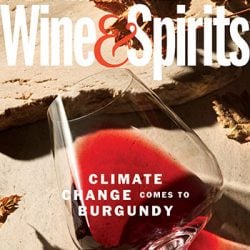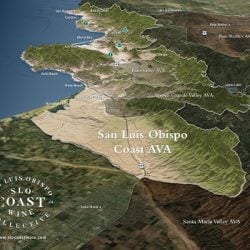By the end of April, most of California wine country had entered Severe Drought conditions. We began to hear from growers weighing their options given the limited water the season would provide. So, we enlisted David Darlington to track their progress as the season unfolds.
David has written on water issues for W&S in the past (see “The Parching of Paso Robles,” posted here in January of 2014) and the wild fires that can follow drought conditions (“California’s Ecology of Fire,” posted December 2017). He will be following several growers as they navigate this season, with a web post every other week, as part of a research project on how the drought may impact the wines of 2021. For his first post, he spoke with Rory Williams, who dry farms vines at Frog’s Leap. —Ed.


Rory Williams, 37, is director of winemaking and viticulture at Frog’s Leap Winery. Williams, who also has his own label at the Calder Wine Company, grew up in Napa Valley. His education took him in a classical “great books” direction at St. John’s College in Annapolis, Maryland, followed by graduate work in food science at Cornell University, where he focused on flavor research. During his academic studies, he had harvest internships in Burgundy, Barolo, Provence, and Mendoza; he returned to Napa in 2010 and in 2012 started working formally at Frog’s Leap, which was co-founded by his father, John, in 1981. Rory’s mother, Julie Johnson, is proprietor of the Tres Sabores winery.
The Williamses are longtime adherents of organic dry farming – growing crops without benefit of irrigation or pesticides. We talked to Rory about their demanding protocols and prospects in the face of severe drought; his observations have been edited and condensed. —David Darlington
At the moment, the sky isn’t falling – we haven’t really seen significant impacts on growth so far [this year]. There haven’t been any heat waves yet, but the vines are pretty well prepared. They’re behaving normally – not huge or giving tons of fruit, but also not freaking out or showing signs of extreme water stress, like cupped leaves, stunted growth, or inability to ripen their fruit. There’s variation across the field, but even in the weakest blocks – those planted in gravelly, well-drained soil, which tends to lose a larger proportion of its available moisture early in the season – they’re behaving quite normally. My theory, which is purely speculative, is that since they never seem to get much water, they’re not especially troubled by low rainfall and are pretty well tuned in to the way this year is going. I’ve heard the same thing from other people with dry-farmed vines – it’s not perfect, everybody wanted more rain, but we’re still seeing vines respond positively. It’s not as big a growth year as 2017, which had twice the annual average rainfall; the vineyard isn’t setting itself up to have to support such a large canopy, but it’s still enough for a commercial crop. We interpret that as being pretty well adapted to getting a low amount of water.
Dry farming is not the same thing as just turning off the water. It’s a system of building up the soil’s water-holding capacity and organic matter with cover crops and compost. So far this year, we haven’t done anything different – we make cultivation passes at critical times, which is standard practice in a wet year or a dry year. Interestingly, the lack of rainfall over the winter allowed the cover crop to grow extremely big. Each fall we plant vetch, peas, fava beans, oats, daikon radish and triticale; and there’s the voluntary mustard that lights up the valley every February. Rain can actually compact the soil—if you overwater something, it’s not going to grow real well, but a little bit of rainfall with warm, sunny days is a great way to grow a garden or a cover crop. That was an opportunity to till an enormous amount of organic matter back to into soil.
Our job as farmers is to try and set up conditions for the vine to make decisions on its own. To a certain degree it’s out of our control, and that’s okay – we depend on the vine’s ability to adapt and grow with the seasons. Not to anthropomorphize and say it’s looking at weather forecasts, but dry weather in February is a signal to the vine that it might need to grow in a different way: “If I grow too much and run out of energy, I won’t be able to ripen my seeds, but if I grow too small I’m taking a risk about wasting a potential source of energy.” It’s trying to use every resource available to it to accomplish certain tasks. It isn’t interested in 100-point cabernet; it’s interested in growing big enough to compete with its neighbors, ripen its seeds, spread them out and harden off for winter. We trust the vines to respond in a way they need to in order to bud out, flower, go through veraison and ripen their grapes. Allowing them to adapt year by year enables them to be more resilient.
If we had vines with a massive canopy [such as irrigated vines can have], it would be more of an issue. Nobody in a high-quality Napa Valley vineyard is going to dump a bunch of water on their vines; they’ll supplement only the amount that they need, and if you have an irrigation pond big enough (and full enough), your only limitation is the knowledge of optimal timing and amount. But if you are [totally] out of water, then it gets more difficult – that’s where you’d be looking to reduce yields to match the vine’s weakened growth. If you’re [irrigating] on top of a hill and you run out of well water, that’s where you get vines growing very small and the crop severely reduced.
[As summer continues] we’ll keep our eyes open and look at our protocols. We’ll probably be more careful than usual – prioritize getting the vines suckered and shoot-thinned on time so they’re not supporting any extra growth, thin off a little more fruit, hedge our bets on the low side instead of letting extra crop sit on the vine too long. If we leave too much, the vines might run out of energy and struggle to fully ripen their fruit – then we might have to pick early to avoid losing the crop to November rains or other natural events. It’s definitely a compromise; we normally average 4 tons per acre in our cabernet vineyards, and last year we ended up with 3.4. I would expect about the same this year. If it keeps getting hotter and hotter, my plan is to be extra conservative. I’m not planning for a year when we’re down 50 percent, but the tale hasn’t been written yet in full. It could turn out to be like the summer of 2017, which had extreme heat waves in mid-June, early July, mid-July, late August and Labor Day, followed by the fires in October. We have overhead sprinklers installed at two of our six ranches; they’re normally used for frost control in the spring, but they can also help suppress heat in an emergency. In 2017, we ran them six or seven times. As temperature extremes become more common due to climate change, that will be an increasingly important feature of our vineyard infrastructure. [Even then,] our wells won’t run dry with the [small] amount of water we’re using.
2020 is famous for a number of things. Before the fires and massive heat waves of harvest, it was headed to be an extremely high-quality vintage. Sometimes low-rainfall years lead to very high-quality fruit – if vines have resources to make it [through] the year, they can have tiny berries and high skin-to-juice ratios. But in early June it’s hard to know what will happen. If we get a nice, even summer, we’re probably headed for a good vintage. It’s the other contingencies that tend to get you – heat spikes and weird events like earthquakes and fires. When the Glass fire hit last year, we only had two picks left, and they didn’t see any heavy smoke. So that was good news, in that we had lots of wines that were home free. But we got lucky. I count myself extremely fortunate to have made wine in a year like 2020, so I’m cautious about saying that we did it right and [people who irrigate to prolong the growing season] were wrong. And I’m very reticent to say you should dry farm because you won’t get smoke taint – if nothing else, I consider it bad karma. This year, fires could come in August, July, or the end of October; you could have all your grapes in, but your winery might still burn down. Our winery is surrounded by vineyards, which are natural firebreaks, so it’s not the same danger as in the hills. But the Glass fire jumped the valley [from the east] and started burning Spring Mountain [to the west]. That freaked everybody out. What if a fire sparked from Pritchard Mountain and landed on our red barn?
I’m not sounding [an alarm] like Chicken Little, but the days when we thought of [fires] as hyperlocal are over. Our winery isn’t an island – we have 65 employees, some of whose kids go to school in Napa and St. Helena. When disasters hit, they lose water and power. Last year we hosted families that had to evacuate. So we’re insulated from fires only in the most trivial sense. There are a whole lot of other ways that fire can get here.
W&S's James Beard Award—winning special correspondent David Darlington is the author of five books, among them An Ideal Wine and Angels' Visits: An Inquiry into the Mystery of Zinfandel (later retitled Zin).
This is a W&S web exclusive. Get access to all of our feature stories by signing up today.



















